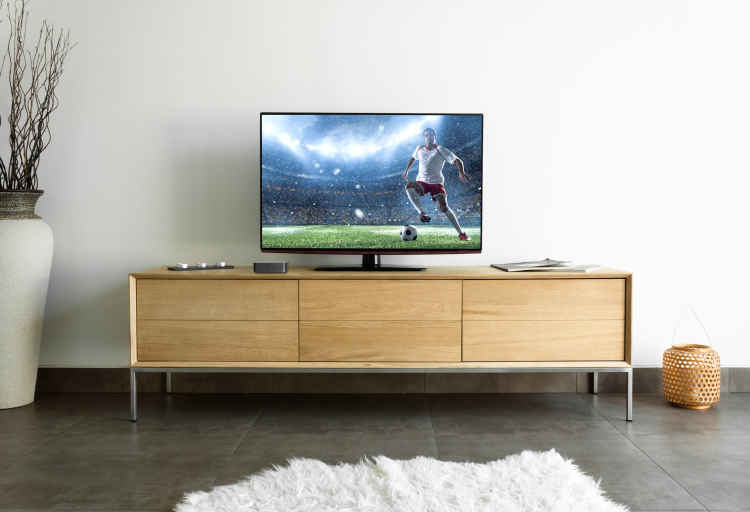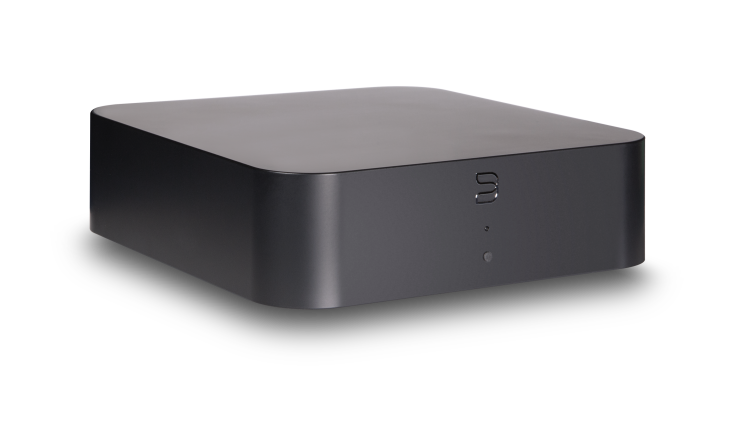Amy Stoneham talks to Peter Gibb, business development for custom install and Matt Simmonds, product manager at Bluesound about the new Bluesound HUB and how it brings multiroom capabilities to any audio source.
Launched in May this year, the Bluesound HUB is the latest innovation for audiophiles and music lovers who want to listen to their favourite music from any audio source throughout their home. With the ability to connect up to five audio inputs, the HUB expands multiroom capabilities by bringing music from any audio source into the BluOS ecosystem.
“The HUB offers another layer of flexibility to the AV installers,” says Simmonds. “It’s a great option for sharing the audio from a specific external source, such as a TV, CD player, turntable or DJ decks to any, or multiple, zones around a property, uncompressed and in perfect sync.”
Establishing the difference between the BluOS and Bluesound ecosystems, Gibb explains: “BluOS is the software-based operating system. This is the music management platform that handles all the music service content, input sources, playback, grouping, player setup and diagnostics.
“Bluesound is one of several hardware implementations for BluOS which is aimed at the consumer/lifestyle end of the spectrum. There are BluOS enabled products from our sister brand, NAD, such as hi-fi components, AV receivers, and our rack mounted CI streaming products. We also licence BluOS to other audio brands who are looking for a reliable, high resolution audio platform. So, while there are around 10 Bluesound products, there are actually over 60 BluOS enabled products on the market today.”
The BluOS app ensures simple set up and control of audio sources through the HUB. Users can connect multiple sources and stream one digital source and one analogue source simultaneously to different zones. For more, up to four HUBs can be used on a network to bring multiple local sources into the system.

With a simple plug and play design, the BluOS controller will discover the HUB and set it up on the network, which can be done wirelessly or through an Ethernet cable, making it ready for the user to connect a source and start playing audio.
Simmonds adds: “The HUB features a range of inputs on the back, including HDMI eARC for audio with CEC for volume control, digital coax, TOSlink, RCA, and most uniquely, a Moving Magnet (MM) phono input. So, the HUB isn’t only this network accessory but it’s also a phono preamp for a Bluesound system.”
Sources can also be customised: within BluOS, they can be renamed or hidden; digital sources have options for auto sensing; AV Mode can be activated, which allows lip syncing; and all sources will natively be played back uncompressed. However, users have the option to compress the audio on a source to alleviate pressure on the network if required.
As a network accessory, Simmonds explains why it fits so well in the wider Bluesound ecosystem: “Currently, almost all BluOS enabled players have local inputs, and all have analogue and digital inputs while others add HDMI and Bluetooth, but until now, the only way to share these in other zones was to group the zones together through the BluOS app. This is easy to do but it doesn’t hit every customer use case scenario.
“The HUB allows users to share any source to any zone, and even multiple zones simultaneously. In BluOS, we support up to 64 zones at the same time, so it adds such flexibility for sources as a local source solution.”
Having such versatility, the HUB fits very well into the CI channel. “System designs and the requirements of a client often change during the course of a project and sometimes afterwards too, even after the main wiring infrastructure has been agreed,” clarifies Gibb. “If you’ve designed and wired for a centralised audio system, where the main audio sources are based in a rack, the HUB provides a solution to wirelessly add localised sources into that system.

“If your primary players are Bluesound Nodes or a 4-zone NAD CI580v2 streamer for instance, but your client then wants to dig out their old vinyl collection and add a turntable, or decides to repurpose a room and add a TV for gaming, the source can be connected locally to the HUB and immediately becomes available to every existing zone in the BluOS system.”
Furthermore, the small form factor and keyhole slots on the bottom means it can be mounted behind a TV or tucked away in an AV cabinet next to the source, ideal for high-end installs. Since it seamlessly slots into BluOS, its inputs can be selected by control systems such as Crestron, Control4, ELAN, URC, RTI, Lutron and KNX.
Gibb concludes: “All BluOS enabled products work seamlessly together, so no matter the product or brand, the customer’s experience is always the same. The level of flexibility this gives the integrator in terms of system design is unparalleled. When looking at a client’s needs on a room-by-room basis, in almost every scenario or use case, there are several options to the installer with varying levels of connectivity, form factor, audio performance and price points. If the use of a room changes after installation, having such a wide choice of products makes it easy to add, change or upgrade the kit without affecting the end user experience and avoiding a lot of reprogramming in the control system if there is one.”
www.bluesound.com/products/hub